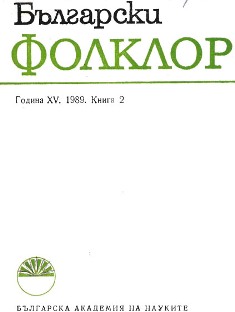Структура и динамика на изпълнението в българския обреден фолклор (Предварителни бележки)
Structure and Dynamism of Performance in Bulgarian Ritual Folklore
Author(s): Iveta Todorova-PirgovaSubject(s): Anthropology
Published by: Институт за етнология и фолклористика с Етнографски музей при БАН
Summary/Abstract: The article presents an attempt to define some basic concepts and methodological formulations indispensable to the analysis of performance in Bulgarian folk rituals. Two assertions have been essential for the author’s observations, namely that, on the one hand, performance is one of the basic forms of existence of the folklore phenomena, and, on the other, performance is subordinate to the peculiarities of the ritual type of situation, with this latter creating a specific atmosphere and setting its “mark” on every single element that “enters its orbit”. Hence, ritual performance should be viewed as a “mechanism, which sets in motion” the ritual components. It is related to the dynamic pattern of description of the rite rather than to the static one. In the second place, ritual performance has been considered as a type of human activity, with ritual personae being its subject, and its object – the ritual texts united by the performers’ actions. In the third place, it has been pointed out that the structure of the ritual performance should be considered by way of the structure of the act of communication, while its dynamism presents the interrelation of the structure-forming elements during the various stages of the ritual process. The author also indicates several levels of analysis, on which performance could be described (those of the rite as an entity, the ritual moment and the single act of performance) and their mutual relationship with the stages of the ritual process (preparatory, initial, proper and final). A concrete analysis of a survakari rite has been proposed in order to illustrate the preliminary theoretical argument. In conclusion, the author states the reasons, which call for further discussion of these problems.
Journal: Български фолклор
- Issue Year: XV/1989
- Issue No: 2
- Page Range: 45-55
- Page Count: 11
- Language: Bulgarian
- Content File-PDF

